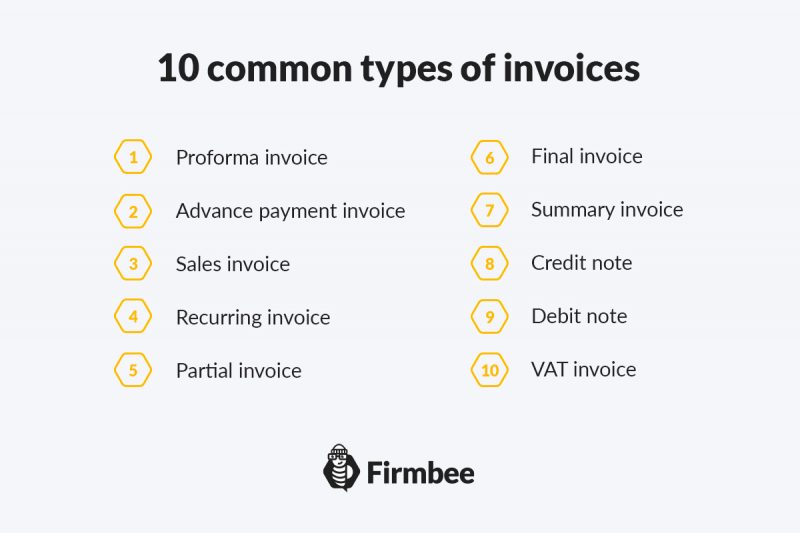Running a business is inextricably linked to issuing invoices and these come in all shapes and sizes. Some are par and parcel familiar ones, while others we have to issue once in a blue moon. Nonetheless, as professionals, we should know how to pick and issue all kinds. This article will outline the necessary basics to help you distinguish and swiftly pick just the right type of invoices.
Types of invoices – table of contents
- Proforma invoice
- Advance payment invoice
- Sales invoice
- Recurring invoice
- Partial invoice
- Final invoice
- Summary invoice
- Credit note
- Debit note
- VAT invoice

Proforma invoice
A proforma invoice, or as some say a preliminary invoice, is a solution designed to showcase your offer to the customers. If they accept your terms and conditions, they will pay the invoice and you can deliver the goods or services detailed.
If customers don’t accept your terms and conditions, they don’t have to pay. It’s because issuing proforma invoices neither obliges customers to pay nor creates any tax obligations.
What conditions imply such an obligation then? Only when the customer pays the proforma invoice. In such a case, you have to issue a normal invoice and pay all the taxes that relate to the sale. What you get is the money even before the processing of the order. How about your customers? They benefit too as the proforma invoice enables the customer to easily and freely compare offers from several companies to pick and choose the right one.
Advance payment invoice
At first glance, the advance invoice is similar to the proforma. But look more closely and you’ll find they vary. An advance invoice involves an obligation to pay, while a proforma invoice is just a proposal to enter into a sales contract.
When is an advance invoice a good pick? Definitely, in case you need to commit significant, from your point of view, financial resources to complete the order. The advance invoice allows you to receive part of the payment from the customer even before selling the goods or services. This will have a positive effect on your liquidity, especially when processing large orders. You can set up the value as a specific percentage of the total order. This gives you more certainty that your customers will not withdraw from the contract, because then they would lose the money already paid.
Sales invoice
This is an ordinary invoice but it cannot be missing from this list. In commercial transactions, such an invoice occurs most often. That’s the document we all have in our mind when we hear the term invoice. Like other types of invoices, it contains all 12 elements any invoice requires. It documents a business event that took place between the seller and the buyer. Such an invoice can cover both the sale of goods and the provision of services.
Recurring invoice
This type of invoice is very common for the provision of services. It is issued on every predetermined period. Most frequently it is a month but you can also find weekly quarterly or annual invoices. These usually appear in the case of various subscriptions.
The fee for each month is set in advance, so you know immediately what amount to pay. This feature of recurring invoices makes it very easy to automate the issuance of such type of invoices. By using an invoicing application, the process of issuing recurring invoices can become really plain and simple. All you need to do is enter some necessary data and the next invoices will be automatically generated. What data is necessary for this? Usually, the following information will suffice:
- customer data,
- information about what the invoice is for,
- the invoice amount,
- what time the next invoice should be issued,
- date of payment.
For recurring invoices, each subsequent invoice is very similar to the first invoice that was issued. They will differ in number, date of issue and sale, and due date. If you know the email addresses of your customers, you can also have your invoicing software send these invoices automatically, which will certainly save you a lot of time.
Partial invoice
In the case of large projects, partial invoices are popular. In this situation, the agreed work gets divided into stages. When a particular stage is fulfilled, you issue a partial invoice. This method of invoicing applies to both the supply of goods and the provision of services. It is best to establish the payment schedule earlier, already at the stage of signing the contract. This way you’ll inform your clients beforehand without surprising them with the invoice you issue.
What are the benefits of partial invoices? They will provide you with greater liquidity, while your customer will avoid a very large bill after the completion of the entire order because the payment breaks into parts and spread over time.
Final invoice
This type of invoice typically occurs after completing an order. It can come together with advance invoices or partial invoices. You issue the final invoice by calculating the amount which is the difference between the completed and settled invoices to date and the total amount of the contract. How to do it? You must subtract the value of the advance or partial invoices you have issued for the project from the total project value.
Summary invoice
A summary invoice is practical when a customer has placed several orders with you. You do not need to issue a separate invoice for each order. In this case, you can use a summary invoice. Of course, to make this solution advantageous for you, individual orders cannot be stretched over time. Why? You have to remember that you will receive the money only after some time after issuing the invoice. Therefore, if you wait too long before issuing a summary invoice, the money will be credited to your account for the completed orders.
In practice, you can schedule a summary invoice every certain period, for example, a week or a month. At the end of the week or month, you put together all the orders you’ve made for that customer and prepare a single summary invoice. You can also use this type of invoice when a customer has placed an order but later added something else. In this case, you don’t need to prescribe two separate invoices, but you can include both orders in the summary.
Credit note
A credit note is a type of credit invoice. It’s typically used when a customer has returned a product, paid for a product but wants to cancel the order, or received damaged or undersized merchandise that involves a price reduction as compensation. You can also hand out this note when you want to give a customer an additional discount after their order has been completed and paid for. It is also applicable when an invoice contains an incorrect and inflated total value, thus requiring adjustments.
A credit memo means that the seller owes money to the buyer. It is a confirmation from the seller that he or she has given the buyer some form of credit. The buyer can use this credit for future purchases or ask for a refund.
Debit note
This is the type of corrective invoice you send to a customer when you make a mistake in understating the value of goods or services sold. A debit note means that in addition to the invoice amount, the customer also owes you the amount for which the note was issued. The difference between a credit or debit invoice and a regular invoice is that you send the regular invoice when the goods or services are sold. The credit or debit invoice, however, occurs after the regular invoice has been issued to correct the amounts shown on the invoice.
VAT invoice
In countries where there is VAT (value-added tax), a very common type of invoice is the VAT invoice. It documents the sale of goods and services by entities that are VAT payers. This is generally the majority of companies that operate in such countries. Interestingly, even if there is no VAT in your country, if you sell goods or services to countries where there is VAT, you may be required to issue an invoice that includes VAT.
Read also: 5 common invoicing mistakes
If you like our content, join our busy bees community on Facebook, Twitter, LinkedIn, Instagram, YouTube, Pinterest.
Author: Andy Nichols
A problem solver with 5 different degrees and endless reserves of motivation. This makes him a perfect Business Owner & Manager. When searching for employees and partners, openness and curiosity of the world are qualities he values the most.


















